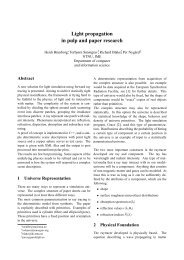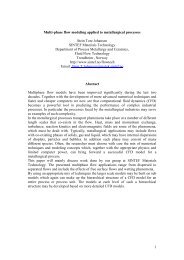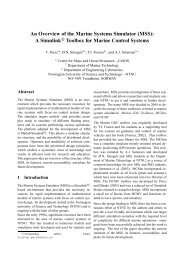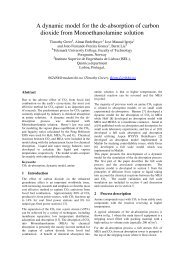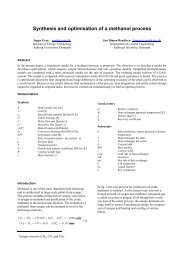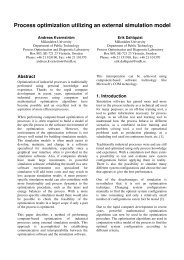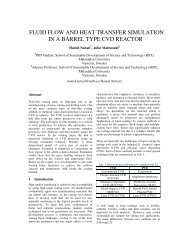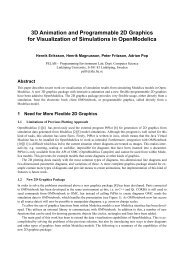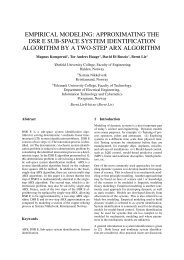detailed programme - SIMS - Scandinavian Simulation Society
detailed programme - SIMS - Scandinavian Simulation Society
detailed programme - SIMS - Scandinavian Simulation Society
You also want an ePaper? Increase the reach of your titles
YUMPU automatically turns print PDFs into web optimized ePapers that Google loves.
Keyword: CO2 capture, Stripping column, Dynamic modeling<br />
Abstract: Post combustion CO2 capturing holds an important position in the area<br />
of carbon capture and sequestration (CCS). Research is operating in this area<br />
ranging from experimental work to modeling work. Dynamic models are<br />
interesting since these describe the plant operation during variations, up-stream<br />
or<br />
down-stream.<br />
A dynamic model of a stripping column of a CO2 capture plant has been<br />
developed. The stripping column model is equipped with a tower model,<br />
condenser model together with a reflux drum and a re-boiler model. The model<br />
has been validated against pilot plant data found in the literature for steady state<br />
predictions.<br />
The non-equilibrium stage rate based modelling is used to describe the stripping<br />
tower, and it is discretized into a number of control volumes. Each volume in the<br />
discretization consists of a bulk liquid phase, a bulk vapour phase and an<br />
interface with a liquid and a vapour film. The bulk phases in a control volume are<br />
considered as continuous stirred tanks (CST). The specie and the energy<br />
conservation equations are applied for each of the bulk phases. Reactions are<br />
included, except for the vapour phase. The set of liquid phase reactions and<br />
reaction kinetics are taken from the thermodynamic models and the kinematic<br />
data available in literature. The Kent-Eisenberg model is used as the<br />
thermodynamic model to calculate the reaction equilibrium.<br />
Velocity inside the stripping tower has been taken to be constant, while the<br />
pressure drop is distributed linearly among each control volume along the tower.<br />
Mass and energy conservation at the interface is considered assuming that CO2,<br />
H2O and MEA are the only species which transfers across the interface. The<br />
specie transfer rates are calculated according to the driving force which is given<br />
by the difference between the actual and equilibrium specie partial pressures. An<br />
enhancement factor is used to introduce the influence of the reactions on mass<br />
transfer.<br />
The condenser is modelled using flash calculations, a constant pressure and<br />
constant temperature flash (P-T flash), to compute the details of the vapour and<br />
the liquid phases. The liquid leaving the condenser is the feed to the reflux drum<br />
and the reflux flow is manipulated to control the liquid level inside the drum.<br />
Overall mass balance and specie balance are applied to find the liquid level and<br />
the composition of the liquid.<br />
The re-boiler is modelled as a flash drum. A P-T flash with a constant vapour to<br />
feed fraction (V/F) is used to compute the compositions of the liquid and the<br />
vapour leaving the re-boiler. A simple energy balance is performed to calculate<br />
the re-boiler duty.<br />
Sensitivity of the model for the combination of the correlations in use, reactions<br />
in use and the transfer of the minor species are analyzed.<br />
Dynamic model predictions will be presented.<br />
Authors: Sanoja Jayarathna, Achini Weerasooriya, Bernt Lie, Morten Melaaen.<br />
Organization: Telemark University College.



